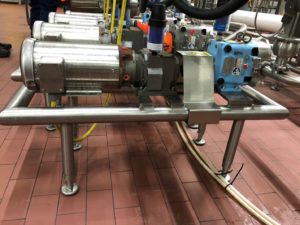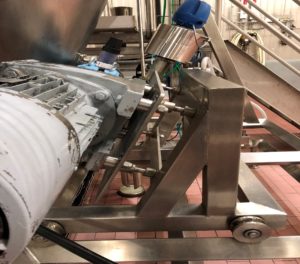This is as much a title for a blog as it is a question. One our Technical Trainers once stated that to align rotating machinery, they must first be alignable. What is meant in part by this is that when we have a collinear tolerance of 0.5mil /1” angularity and 2.0 mils offset, the machines must be mounted to a stable foundation to be able to hold the tolerance.
Flexion of the base in some cases makes precision shaft alignment impossible without some sort of modification to the base or the alignment process. I’m afraid I won’t be able to give a catch all answer to the question as there are too many variables. I will however show you a problem that I encountered during a training session and the solutions that were discussed.
Look at this base in the photo below. What do you see as potential issues when attempting to align the machines?

Here is what we saw:
- These are moved daily for cleaning. They rarely return to the same position on the tile floor.
- The base does have adjustable feet.
- Hollow SS tubing for a base, with 4 points of contact.
- Gearbox with an overhung motor mounted to the center of the frame base
- No support for the motor feet.
- Power cord pushing against the frame and unsupported.
These are obviously going to affect our attempt achieve a precision shaft alignment. Some engineering and peripheral work will have to be completed to expect this machine to be aligned. Without performing any reconstruction or re-engineering, we were able to maintain tolerance in the horizontal plane, but it was impossible to even come close to holding tolerance in the vertical plane.
Here are the answers (we discussed for these machines) to the question “How Do You Align Machinery on a Flexible Base”:
- Create divots in the floor so that the bases return to the same position on the floor. Use a torque wrench with a needle type indicator to set the down pressure on the feet to minimize a soft foot on the base.
- Stabilize the center of the frame with gussets or a fifth leg to minimize the flex.
- Support the motor.
- Reverse the power input to enter from above. This supports the weight of the cord and moves it away from the frame.
This is a pretty obvious case, not all alignment issues are this easy to see and correct. Sometimes the base may look stable or base stability assumed. When in fact they are not. Occasionally, the corrections are too extreme or costly to implement. Awareness and understanding is key. So, when you perform a precision shaft alignment on rotating machinery, ask yourself;
“What can move and how can I control it?”.
Look at the next picture and see what you could do! Good luck!




